Biographies reflect human experiences in different settings. They are sources of information about times and places in history, as well as accounts of the lives of individuals, including some forgotten in the historical record. The biographies and memoirs reviewed here are thought-provoking stories about lives and moments and periods of history.
Ages 4–8
The Flying Girl: How Aída de Acosta Learned to Soar. Margarita Engle. Ill. Sara Palacios. 2018. Atheneum/Simon & Schuster.
 With lyrical text and bright, mixed-media illustrations, this biography tells the story of how Aída de Acosta (1884–1962) “learned to soar” after seeing a man fly an airship. “If that man can fly, so can I. / All I need are some lessons / and a chance to try!” Although her mother objects, 19-year-old Aída takes lessons from the airship’s inventor, Alberto Santos-Dumont, and—after only three sessions—flies solo. Landing in a polo field, Aída is taunted by observers for unladylike behavior, but Alberto cheers, “You flew! You’re a hero, such a brave inspiration for all the girls of the world!” An author’s note provides background information on Aída’s historic flight near Paris in 1903.
With lyrical text and bright, mixed-media illustrations, this biography tells the story of how Aída de Acosta (1884–1962) “learned to soar” after seeing a man fly an airship. “If that man can fly, so can I. / All I need are some lessons / and a chance to try!” Although her mother objects, 19-year-old Aída takes lessons from the airship’s inventor, Alberto Santos-Dumont, and—after only three sessions—flies solo. Landing in a polo field, Aída is taunted by observers for unladylike behavior, but Alberto cheers, “You flew! You’re a hero, such a brave inspiration for all the girls of the world!” An author’s note provides background information on Aída’s historic flight near Paris in 1903.
—CA
Joan Procter, Dragon Doctor: The Woman Who Loved Reptiles. Patricia Valdez. Ill. Felicita Sala. 2018. Alfred A. Knopf/Random House.
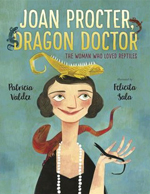 Fascinated by reptiles as a child (she even had a baby crocodile), Joan Beauchamp Procter (1897–1931) eventually became the assistant to the curator of reptiles and fish at the Natural History Museum in London. Her scientific research and creation of reptile exhibits led to her appointment as curator upon her mentor’s retirement. Proctor later designed the London Zoo’s Reptile House, including a special enclosure for the newest additions to the zoo’s reptile collection: two seven-foot-long Komodo dragons. Back matter for this biography includes colorful illustrations of Procter working with reptiles, additional information about her life and work, notes on Komodo dragons, and a bibliography.
Fascinated by reptiles as a child (she even had a baby crocodile), Joan Beauchamp Procter (1897–1931) eventually became the assistant to the curator of reptiles and fish at the Natural History Museum in London. Her scientific research and creation of reptile exhibits led to her appointment as curator upon her mentor’s retirement. Proctor later designed the London Zoo’s Reptile House, including a special enclosure for the newest additions to the zoo’s reptile collection: two seven-foot-long Komodo dragons. Back matter for this biography includes colorful illustrations of Procter working with reptiles, additional information about her life and work, notes on Komodo dragons, and a bibliography.
—CA
Marie Curie. Demi. 2018. Henry Holt.
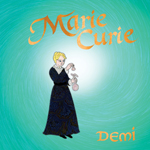 Born in Poland in 1867, Maria Sklodowska Curie dreamed of obtaining a university education at a time when women in Poland were not allowed to attend universities. In 1891, she enrolled at the Sorbonne in Paris, where she not only earned degrees in physics and mathematics, but was also the first woman to earn a doctorate in science in Europe. In 1903, Curie became the first woman to be awarded the Nobel Prize in Physics (shared with her husband, Pierre Curie, and Henri Becquerel) for research on the radioactivity of uranium. In 1911, Curie won the Nobel Prize in Chemistry for her discovery of the elements polonium and radium. Demi’s biography, complemented by colorful mixed-media illustrations, educates readers about Curie's scientific accomplishments and their implications. Back matter includes a timeline, references, and additional resources.
Born in Poland in 1867, Maria Sklodowska Curie dreamed of obtaining a university education at a time when women in Poland were not allowed to attend universities. In 1891, she enrolled at the Sorbonne in Paris, where she not only earned degrees in physics and mathematics, but was also the first woman to earn a doctorate in science in Europe. In 1903, Curie became the first woman to be awarded the Nobel Prize in Physics (shared with her husband, Pierre Curie, and Henri Becquerel) for research on the radioactivity of uranium. In 1911, Curie won the Nobel Prize in Chemistry for her discovery of the elements polonium and radium. Demi’s biography, complemented by colorful mixed-media illustrations, educates readers about Curie's scientific accomplishments and their implications. Back matter includes a timeline, references, and additional resources.
—SW
Up & Down: The Adventures of John Jeffries, First American to Fly. Don Brown. 2018. Charlesbridge.
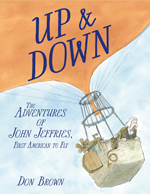 At the end of the American Revolution, loyalist John Jeffries (1745–1819), a Boston physician, fled to England, where he became one of the thousands of Londoners who marveled at the sight of the first manned balloon flight. Seeing the opportunity to measure temperature at different altitudes and observe air currents, Jeffries, an amateur meteorologist, paid the famous French balloonist Jean-Pierre Blanchard to accompany him on a flight over London. The success of the voyage led Blanchard and Jeffries to plan a flight across the English Channel. Beautifully illustrated in oil-based pencil and watercolor, Don Brown chronicles the perilous journey to France made on January 7, 1785. Back matter includes a “More Hot Air” endnote, a bibliography, and quotation sources.
At the end of the American Revolution, loyalist John Jeffries (1745–1819), a Boston physician, fled to England, where he became one of the thousands of Londoners who marveled at the sight of the first manned balloon flight. Seeing the opportunity to measure temperature at different altitudes and observe air currents, Jeffries, an amateur meteorologist, paid the famous French balloonist Jean-Pierre Blanchard to accompany him on a flight over London. The success of the voyage led Blanchard and Jeffries to plan a flight across the English Channel. Beautifully illustrated in oil-based pencil and watercolor, Don Brown chronicles the perilous journey to France made on January 7, 1785. Back matter includes a “More Hot Air” endnote, a bibliography, and quotation sources.
—CA
Ages 9–11
Confucius: Great Teacher of China. Demi. 2018. Shen’s Books/Lee & Low.
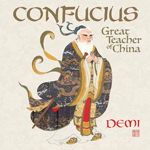 Demi introduces young readers to Confucius (551 BCE–479 BCE) in this beautifully crafted biography. She weaves together legend and fact to tell the story of the Chinese philosopher and teacher’s life and work and incorporates numerous quotes from The Analects, in which students and followers compiled Confucius’ sayings after his death. Her distinctive, delicate illustrations, done in paint and ink and framed in gold and red, exquisitely complete this portrait of Confucius, whose principles of governance and education continue to have influence today.
Demi introduces young readers to Confucius (551 BCE–479 BCE) in this beautifully crafted biography. She weaves together legend and fact to tell the story of the Chinese philosopher and teacher’s life and work and incorporates numerous quotes from The Analects, in which students and followers compiled Confucius’ sayings after his death. Her distinctive, delicate illustrations, done in paint and ink and framed in gold and red, exquisitely complete this portrait of Confucius, whose principles of governance and education continue to have influence today.
—CA
The Secret Kingdom: Nek Chand, a Changing India, and a Hidden World of Art. Barb Rosenstock. Ill. Claire A. Nivola. 2018. Candlewick.
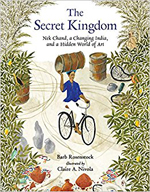 Full of stories he heard from his family and visitors in his village north of Lahore (now Pakistan), Nek builds a small world of his own on the banks of a stream, creating a palace from silt and people and animals from clay, sticks, and rocks. With the 1947 partitioning of the country, he is forced to flee his home and settle in Chandigarh, the first planned city in the new India. Lonely for the people and places of home, Nek builds “a secret kingdom” with rocks, boulders, and discarded items on undeveloped scrubland near the city. When the government threatens to destroy his magical world, which he has kept secret for 15 years, people from Chandigarh come to the rescue. Beautiful watercolor and gouache illustrations suggest a sense of place. A final double gatefold opens to display a collage of photographs with views of the 25 acres of artwork (on the 45-acre “Rock Garden” site) that Nek Chand created over his lifetime. Back matter includes an author’s note with additional information about Nek Chand Saini (1924–2015) and the Rock Garden and a bibliography.
Full of stories he heard from his family and visitors in his village north of Lahore (now Pakistan), Nek builds a small world of his own on the banks of a stream, creating a palace from silt and people and animals from clay, sticks, and rocks. With the 1947 partitioning of the country, he is forced to flee his home and settle in Chandigarh, the first planned city in the new India. Lonely for the people and places of home, Nek builds “a secret kingdom” with rocks, boulders, and discarded items on undeveloped scrubland near the city. When the government threatens to destroy his magical world, which he has kept secret for 15 years, people from Chandigarh come to the rescue. Beautiful watercolor and gouache illustrations suggest a sense of place. A final double gatefold opens to display a collage of photographs with views of the 25 acres of artwork (on the 45-acre “Rock Garden” site) that Nek Chand created over his lifetime. Back matter includes an author’s note with additional information about Nek Chand Saini (1924–2015) and the Rock Garden and a bibliography.
—SW
Ages 12–14
Claiming My Place: Coming of Age in the Shadow of the Holocaust. Planaria Price (with Helen Reichmann West). 2018. Farrar, Straus and Giroux .
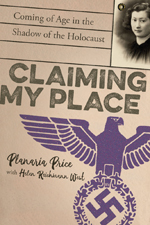 Price tells the life story of Barbara Reichmann (1916–2007), born Gucia Gomolinska in central, predominantly Catholic Poland. As a teen before World War II, she becomes a leader in the Zionist movement—until the Nazis invade Poland in 1939 and establish the first Jewish ghetto in her town of Piotrko´w Trybunalski. After obtaining false identity papers as Danuta Barbara Tanska (nicknamed Basia), blonde, blue-eyed Gucia poses as a Catholic Pole and spends the war years working in Poland, Germany, and Switzerland, always in danger of being caught. At the end of the war, she reunites with a few surviving family members, and in 1951 immigrates to the United States. “New Beginning,” an afterword by her daughter, Helen Reichmann West, completes this story of a courageous young woman determined to survive the Holocaust. Special features that help tell the story include a 16-page photo album, maps, and an endnote on what happened to members of the Gomolinski family and other characters in the story.
Price tells the life story of Barbara Reichmann (1916–2007), born Gucia Gomolinska in central, predominantly Catholic Poland. As a teen before World War II, she becomes a leader in the Zionist movement—until the Nazis invade Poland in 1939 and establish the first Jewish ghetto in her town of Piotrko´w Trybunalski. After obtaining false identity papers as Danuta Barbara Tanska (nicknamed Basia), blonde, blue-eyed Gucia poses as a Catholic Pole and spends the war years working in Poland, Germany, and Switzerland, always in danger of being caught. At the end of the war, she reunites with a few surviving family members, and in 1951 immigrates to the United States. “New Beginning,” an afterword by her daughter, Helen Reichmann West, completes this story of a courageous young woman determined to survive the Holocaust. Special features that help tell the story include a 16-page photo album, maps, and an endnote on what happened to members of the Gomolinski family and other characters in the story.
—CA
March Forward, Girl: From Young Warrior to Little Rock Nine. Melba Pattillo Beals. Ill. Frank Morrison. 2018. Houghton Mifflin Harcourt.
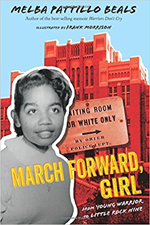 Melba Beals, one of the nine students who integrated Central High School in Little Rock, Arkansas, in 1957, recounts her family life, elementary and middle school days, and her striving for a quality education. Knowing from a young age the discrimination and segregation that oppressed the black community, she dreamed of freedom and of the opportunities that white people enjoyed. Beals describes her efforts to be an exemplary student with the support of her grandmother and modeling of her mother, against great odds. The book includes archival photographs, an epilogue, and a note to readers that provide more information about her life.
Melba Beals, one of the nine students who integrated Central High School in Little Rock, Arkansas, in 1957, recounts her family life, elementary and middle school days, and her striving for a quality education. Knowing from a young age the discrimination and segregation that oppressed the black community, she dreamed of freedom and of the opportunities that white people enjoyed. Beals describes her efforts to be an exemplary student with the support of her grandmother and modeling of her mother, against great odds. The book includes archival photographs, an epilogue, and a note to readers that provide more information about her life.
—SW
Roses and Radicals: The Epic Story of How American Women Won the Right to Vote. Susan Zimet. 2018. Viking/Penguin.
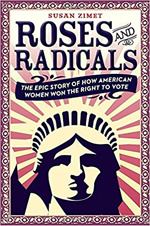 Highlighting leaders of the women's suffrage movement, Zimet chronicles the turbulent journey that led to the passage of the 19th Amendment. She details the life and work of such notables as Lucy Stone and Alice Paul to make suffrage a national priority. The depiction of their persistence, in the face of good, bad, and ugly public responses, is dramatic and heartrending. Quotations from the suffragists’ writings and speeches bring their personalities into focus. With archival photographs, source notes, and a bibliography, the book is a valuable historical resource and an exciting reading experience.
Highlighting leaders of the women's suffrage movement, Zimet chronicles the turbulent journey that led to the passage of the 19th Amendment. She details the life and work of such notables as Lucy Stone and Alice Paul to make suffrage a national priority. The depiction of their persistence, in the face of good, bad, and ugly public responses, is dramatic and heartrending. Quotations from the suffragists’ writings and speeches bring their personalities into focus. With archival photographs, source notes, and a bibliography, the book is a valuable historical resource and an exciting reading experience.
—SW
Ages 15+
Americanized: Rebel Without a Green Card. Sara Saedi. 2018. Knopf/Random House.
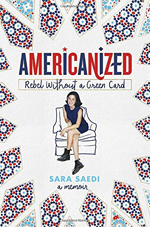 Only 2 years old when her family fled Iran, Sara didn't learn of her undocumented status until 11 years later, when her older sister needed a Social Security number to apply for an after-school job. This memoir chronicles her teenage years, during which she longs for a boyfriend and her own car, enjoys the company of friends, and experiences anguish about the security of her family as they spend years trying to obtain legal citizenship. Saedi’s humorous description of the traditions and practices of her extended family and Iranian culture make this informative book a pleasure to read.
Only 2 years old when her family fled Iran, Sara didn't learn of her undocumented status until 11 years later, when her older sister needed a Social Security number to apply for an after-school job. This memoir chronicles her teenage years, during which she longs for a boyfriend and her own car, enjoys the company of friends, and experiences anguish about the security of her family as they spend years trying to obtain legal citizenship. Saedi’s humorous description of the traditions and practices of her extended family and Iranian culture make this informative book a pleasure to read.
—SW
Fly Girls: The Daring American Women Pilots Who Helped Win WWII. P. O’Connell Pearson. 2018. Simon & Schuster.
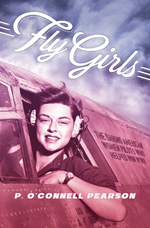 When the United States entered World War II, military officials realized that skilled pilots were needed to operate bigger and more powerful aircrafts. But only men were allowed in military airplanes, even if the expert pilots who trained them to fly were women. A group of 1,100 determined female pilots—who had to prove their worth time and time again—ultimately formed the Women Air Force Service Pilots (WASP). They risked their lives testing new aircraft designs and flying for target practice. They transported planes from one post to another in the U.S. and rose to meet each challenge with resourcefulness and expertise—even when met with discrimination from military personnel. The book includes source notes, an extensive bibliography, and an epilogue noting lives of the pilots after the WASP was disbanded and the recognition they finally received in the 21st century.
When the United States entered World War II, military officials realized that skilled pilots were needed to operate bigger and more powerful aircrafts. But only men were allowed in military airplanes, even if the expert pilots who trained them to fly were women. A group of 1,100 determined female pilots—who had to prove their worth time and time again—ultimately formed the Women Air Force Service Pilots (WASP). They risked their lives testing new aircraft designs and flying for target practice. They transported planes from one post to another in the U.S. and rose to meet each challenge with resourcefulness and expertise—even when met with discrimination from military personnel. The book includes source notes, an extensive bibliography, and an epilogue noting lives of the pilots after the WASP was disbanded and the recognition they finally received in the 21st century.
—SW
Sandip LeeAnne Wilson serves as professor in the School of Education and the English Department of Husson University, Bangor, Maine. Carolyn Angus is former director of the George G. Stone Center for Children's Books, Claremont Graduate University, in Claremont, California.
These reviews are submitted by members of the International Literacy Association's Children's Literature and Reading Special Interest Group (CL/R SIG) and are published weekly on Literacy Daily.